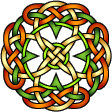 Gordon History
Gordon History
 |
The Gordon's are an ancient
family probably descended from the Gorduni, a
tribe in Ancient Gaul, whose ivy leaf emblem is
the badge of the clan to this day.
The first Gordon's in Scotland
came to England from Normandy with William the
Conqueror and found their way north with the
Norman-loving sons of Malcolm III. They were a
fighting clan. Adam de Gordon joined Louis XI of
France on a Crusade in 1270, and a Gordon is said
to have killed Richard the Lion Heart of England.
The Gordon's supported Wallace
and Bruce in the Wars of Independence. Sir Adam Gordon was Bruce's ambassador to the Pope
and bearer of the Declaration of Arbroath (the document declaring Scottish Independence in
1320). The estates eventually came to an heiress,
Elizabeth, who married Alexander Seton. Her son
was created Earl of Huntly in 1449.
Huntly Castle was said to
resemble a royal palace because of the feasts and jousting that went on. James IV arranged for the
marriage of Lady Catherine Gordon, a famed beauty
called "The White Rose of Scotland", to
Perkin Warbeck, pretender to the English throne.
Warbeck claimed to be one of the princes who was
supposed to have been murdered in the Tower by
Richard III. He was eventually captured and
executed. His wife died in 1537, three husbands
later.
The 4th Marquis was created
the Duke of Gordon in 1684. The chief of the
Gordons was invariably known as "The Cock of
the North", a tribute to the clan's
immense power and influence. In 1798 Jean,
Duchess of Gordon, raised the 2nd Battalion of
the Gordon Highlanders. She placed the
king's shilling between her lips and the
Highlanders came in hundreds to receive "a
kiss o' the Duchess Jean".
On the death of the 5th Duke without issue in 1836 the chiefship passed to the
Earl of Aboyne, who became Marquis of Huntly.
John, the 5th Earl of Haddo, was imprisoned in a
hole in St. Giles Cathedral in Edinburgh called
"Haddo'
s Hole"and executed in
1644 for supporting Charles I. |
|

